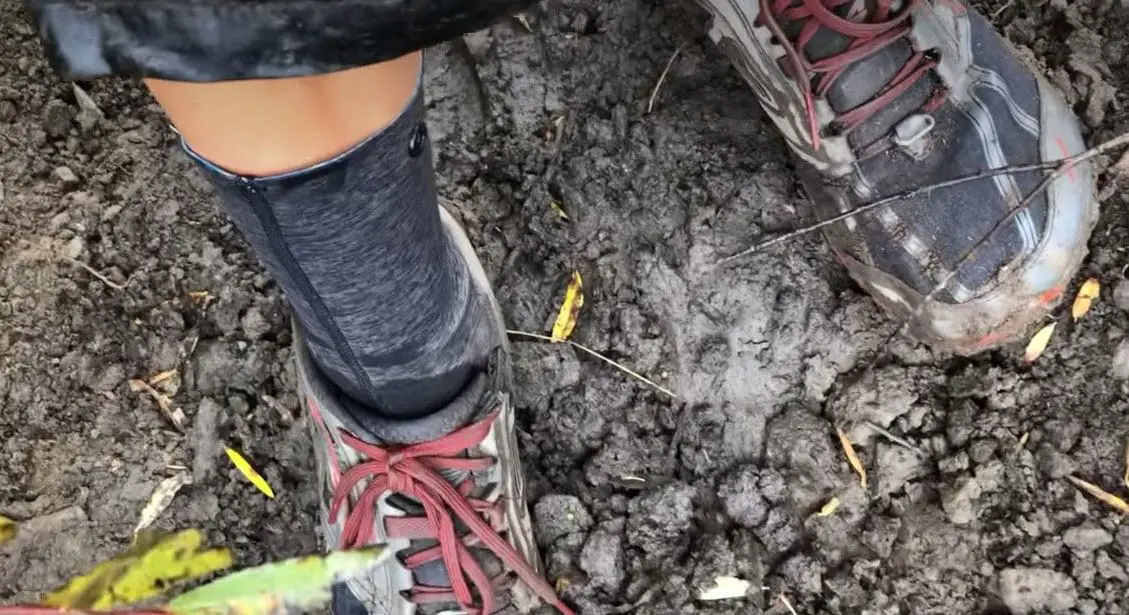Hikers use neoprene socks for many different reasons, including staying warm, staying dry, and protecting their feet. They are also used for other outdoor activities, especially water activities like swimming, kayaking, boating, or canyoneering.
Neoprene is a synthetic material similar to rubber or latex and is also commonly used to make wetsuits and other aquatic clothing and accessories. Like these items, neoprene socks are great to wear if you will be hiking in wet weather or a body of water.
Neoprene socks have other benefits that make them great to wear for outdoor activities. This article will explain the benefits of neoprene socks, how to choose which neoprene socks to buy, and why neoprene socks are good for hiking.
Table of Contents
Benefits of Neoprene Socks
Neoprene socks have a lot of benefits, especially when compared to regular socks made from cotton. Below are all the benefits that you can expect when you wear neoprene socks.
Neoprene Socks are Waterproof
Whether you are hiking in wet conditions, hiking through water, or are expecting rain on your hike, keeping your feet dry is crucial. Neoprene socks are made from neoprene which is a waterproof material. With neoprene socks, not only will your socks stay dry, but so will your feet.
It is beneficial to keep your feet dry when hiking to prevent falling or slipping on rocks or other wet grounds. You will also be able to hike through puddles, shallow rivers, or lakes without having wet feet for the remainder of your hike.
Finally, if you will be doing any water sports like kayaking, you can wear your neoprene socks while you are in the water and still have dry feet after for the remainder of your day or hike.
Neoprene Socks are Warm
When you are hiking in colder weather, neoprene socks can keep your feet warm. If you are going to be in cold water, not only will your feet stay dry, but they will stay warm too.
Furthermore, neoprene socks can be beneficial to wear in colder weather. They may not be best if you will be in freezing weather for a long time, but they can protect your feet from snow or cold weather for a little while.
Even though there are socks and clothing that keep you warm, there may be some weather that is too cold to hike in. Make sure you know how cold is too cold for hiking.
Neoprene Socks Protect Your Feet
Neoprene socks are made from a material that will not rub against your feet. This material will keep you from getting blisters. You can also get blisters from wet feet, so keeping your feet dry is important too.
Additionally, neoprene socks can have some cushioning at the bottom to save your feet from cuts and bruises on rough surfaces. The bottom cushion will depend on the type and thickness of neoprene socks that you wear, but keeping your feet comfortable will make your hike better.
Neoprene socks are also made of a material that can protect your feet from heat. If you are in the sun or the trail is hot, your socks will keep your feet from getting burnt. They can also prevent your feet from sweating too much since they will be cool, keeping them dry and avoiding rubbing, which causes blisters.
Things to Consider When Buying Neoprene Socks
If you are going to wear neoprene socks when you hike, you want to make sure that they effectively protect your feet. These are the things that you need to consider when you buy neoprene socks.
First, make sure you choose the right thickness and height. If you are wearing shoes over your neoprene socks, you need to make sure that your socks are not too thin, that your feet move in your shoes, and they can not be too thick where they squish your feet.
In cold weather or water, thicker neoprene socks will keep your feet warmer. On the other hand, thinner socks will keep your feet cool but still dry in hot weather.
As for the height of your socks, there are multiple options you can choose from. If you are not wading through water or in a lake or river, ankle socks will be adequate.
However, if you walk through water that goes up to your knees, ankle-high neoprene socks will not work. If the water goes above the top of your socks, water can seep in. Make sure you buy socks that are high enough, without being too high that they are uncomfortable.
Finally, some people can have an allergic reaction to neoprene. If you have experienced allergic reactions to latex or other synthetic materials in the past, neoprene socks will likely not work for you.
Even if you are not allergic to any synthetic materials, you may want to wear the socks at home before you wear them for a whole day while hiking. The last thing you want is to have a bad reaction to your socks when you are in the middle of a trail or doing water activities.
How Tight Should Neoprene Socks Be?
Your neoprene socks should be tight enough that they fit your feet and legs or ankles if they are taller socks. However, they should not be so tight that they are uncomfortable or cut off your circulation.
If neoprene socks are too loose, water can get into them and surround your feet. Not only will this be extremely uncomfortable, but you will also have wet feet, which leads to blisters.
If you are wearing tight shoes over your neoprene socks, you want to find thin socks that do not smother your feet. If you choose a thick pair of neoprene socks, make sure you have shoes with a bit of extra space so that the socks fit.
It is important to remember that neoprene socks fit differently than standard socks. They may feel funny at first, but if you can get a proper fit, they will be great for protecting your feet on a hike.
Are Neoprene Socks Good for Hiking?
Yes, neoprene socks are good for hiking. Hikers often use them, and they have many benefits for on the trail, as long as you will not be in extremely cold weather.
First, neoprene socks can keep your feet warm in cold weather since the material holds heat well and can keep your feet dry from snowy trails. If you are hiking in a cold, wet climate, neoprene socks are great, but you will want multiple layers on your feet to stay warm if it is too cold.
If you are looking for a warmer alternative to wear in colder weather, you can try Bombas Socks for your hiking socks.
If you are hiking in warm weather and the ground is hot, your neoprene socks can keep your feet safe from the ground. They also keep your skin covered if you will be in the sun and help you prevent sunburn.
Furthermore, neoprene socks can dry quickly if you are on a multi-day hike where you will need to re-wear a pair of socks. As long as you ring them out and hang them up, they should dry within a few hours, depending on the thickness.
You can also dry them using a fan, but it is important not to use heat to dry them, like with a hairdryer or near a fire. Using heat on neoprene socks can ruin the material or the shape that makes them effective.
Additionally, if you are hiking for multiple days, you need to make sure that you have enough socks. Make sure you know how many pairs of socks you should bring backpacking, whether they are neoprene socks or not.
Final Thoughts
Neoprene socks are great for many outdoor activities, including hiking. They will keep your feet dry, warm, and safe from the other elements that you encounter on your hike. They are also great if you will be hiking in a wet climate, rain, or through any water like large puddles or rivers.
Neoprene socks come in many different thicknesses, styles, and heights, and it is important to choose the best one for you and the type of hiking you are doing. Make sure they are not too thick, high enough on your legs, and feel comfortable on your feet so that you can benefit from your neoprene socks.

